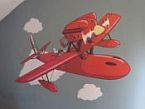wdolson
Posts: 10398
Joined: 6/28/2006
From: Near Portland, OR
Status: offline

|
One of the problems with trying to turn Midway into Japan's Malta is the northern Hawaiian islands don't have very good sites for air bases and only the longest range aircraft could be used to put pressure on Midway itself. Trying to run convoys into Midway would have been expensive, especially if the USN carriers were still afloat and undamaged, but the USN knew they didn't have a deep enough bench to use the carriers for repeated raids on Midway. The pilot training program was ramping up stateside, but they really didn't have enough pilots for near continuous operations until late 43. The battles of 42 depleted the USN pilot pools pretty deeply. Not only were a number lost in combat, but a number were disabled (because shoulder harnesses weren't in use at the start of the war AG 6 alone lost two pilots in the early months when the were thrown forward in accidents and lost and eye on the tube sight sticking through the windshield, Dick Best had his lung so badly damaged at Midway he never flew again, and the list goes on). A lot of pilots were also moved into other jobs that took them out of the front line pilot pool, some in training schools, but many became staff officers supporting the growing need for new staffs for the new fleet carriers.
Many of the survivors of the 1942 battles who did serve second tours ended up in leadership positions in new squadrons created in the massive expansion.
Back to Midway... Politically the Joint Chiefs and elected government wanted headline grabbing victories, not battles of attrition. Battles of attrition could be very costly to the Japanese at somewhere like Midway, but there was little there to make splashy headlines. On the other hand a naval battle that even caused serious damage to the IJN carriers would be great newspaper fodder. If the IJN carriers had survived only to go through refits like the Mogami went through would have been almost as big a victory. Though they may have become available again sometime in 1943, which may have slowed operations to some extent.
Osprey has a series of books in the Duel series and there is one of USN vs IJN carrier which goes over the carrier battles of 1942. Having them all laid out like that, the USN's track record in carrier battles was not great, especially the early ones. In 1942 they had one outstanding day and fairly poor performance otherwise. The book doesn't cover the later two carrier battles other than in passing, but Leyte was deliberately one sided with the carriers sacrificed to allow the BBs to get through. The Battle of the Philippine Sea is a masterstroke of defense on the USN's part, but on offense performance was not great, especially considering the lopsided force balance the USN had (though they were hampered by a long range strike very late in the day). USN subs did much better in that battle on offense.
Bill
_____________________________
WitP AE - Test team lead, programmer  |
 Printable Version
Printable Version


















 New Messages
New Messages No New Messages
No New Messages Hot Topic w/ New Messages
Hot Topic w/ New Messages Hot Topic w/o New Messages
Hot Topic w/o New Messages Locked w/ New Messages
Locked w/ New Messages Locked w/o New Messages
Locked w/o New Messages Post New Thread
Post New Thread